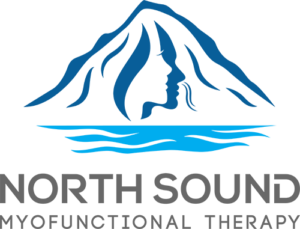FAQs & Resources
Related to Insurance, HSA, and Discounts
Unfortunately, orofacial myofunctional therapy is often not recognized or allowed at this time. Reimbursement is dependent on a person’s plan and out-of-network benefits. It’s best to check with your medical insurance provider.
Absolutely!
Yes! A payment plan over the course of treatment is available.
Yes, a 5% cash or check discount is offered when paying for the comprehensive program in full on the first session.
General Questions
Orofacial Myofunctional Therapy is neurological re-education exercises to assist the normalization of the developing, or developed, craniofacial structures and function. It is related to the study, research, prevention, evaluation, diagnosis and treatment of functional and structural alterations in the region of the mouth (oro), face (facial) and regions of the neck (oropharyngeal area).
The main problems related to OMDs are alterations in breathing, sucking, chewing, swallowing and speech, as well the position of the lips, tongue (including what is known as oral rest posture), and cheeks.
Related to Lingual Frenulum or Tongue-tie
Tongue-tie is a condition in which the tiny string of tissue under the tongue (called the lingual frenulum or frenum) is tight, restricting normal tongue movement. Tongue-ties come in varying degrees of restriction. Generally speaking, surgical treatment is not necessary if there are no symptoms or functional limitations.
A specialist in Orofacial Myofunciotnal Therapy should be well suited to detect a tongue-tie since they should know about the lingual frenulum and also the normal way the newborn sucks. In the case of infants, a pediatrician and a lactation consultant may also be involved.
Yes, but there are varying degrees of tongue-tie, so the importance of having a test or validated protocol that evaluates the tongue and the “trickle” under the tongue (lingual frenulum) is crucial, as well as the way the infant sucks. This will ensure an accurate diagnosis, and indicate whether or not the need to do a frenotomy (or small “cut” under the tongue) is recommended.
When the tongue cannot perform all the necessary movements and thus jeopardizes the way of sucking, swallowing, chewing or talking, a small surgery or frenotomy in the tongue is indicated. The “cut” of the frenum in infants is a simple procedure done with scissors, scalpel, or laser and anesthetic gel, which lasts about five minutes. In older children and adults the most common procedure is the frenectomy (partial removal of the lingual frenulum).
In infants, surgery is usually indicated when the lingual frenulum restricts the tongue’s movement and compromises breastfeeding. A lactation consultant knowledgeable about tongue-tie in infants is a good idea if breastfeeding for mom and baby is not going well. In older children and adults, the indication is made when the tongue is visibly restricted, is unable to adequately reach the palate, or when possible distortions in speech are caused by limitation of the elevation of the tongue tip (especially in producing the sound of the “L” and “R”) that could not be corrected in speech therapy.
Many people with tongue-tie suffer the consequences without knowing the cause. There are infants who have changes in the feeding cycle, causing stress for the infant and for the mother; there are also children with difficulties in chewing, children, and adults with speech problems affecting communication, social relationships and professional development. With the chronic oral rest posture of the tongue in the floor of the mouth, many of the Orofacial Myofunctional Disorders (OMDs) enumerated above may result.
Related to Mouth Breathing
Mouth breathing refers to breathing performed predominantly by the mouth. In this way of breathing, the individual does not use, or uses very little, the nose to inhale and exhale.
Yes in several aspects, such as the mouth’s and face’s structures and their function, including sleep, feeding, learning, hearing and speech.
The person may have one or more of the following characteristics: nasal congestion, open mouth at rest; parched lips, lip color change, appearance of a large tongue that may be recessed and projected forward; long face syndrome; forward head posture; dark circles under the eyes, sagging cheeks, wheezing, and snoring. In such cases it is recommended that an otolaryngologist (ENT) and/or allergist be consulted.
Yes, when breathing is done through the nose, the air is filtered (cleaned), warmed and humidified, and thus it reaches the lungs with less impurities that are in the air. When you breathe through your mouth the air does not go through this process and reaches the lungs full of impurities. The oral rest posture of the tongue and the mandible when mouth breathing may also alter mandibular posture, palate width, and other craniofacial growth patterns as well as posture of the head, neck, and upper body.
The most common causes of mouth breathing are: allergic rhinitis, sinusitis, bronchitis, enlarged adenoids; enlarged tonsils; weakness or low tone of facial muscles that may lead to open mouth rest posture, habits such as thumb sucking, tumors in the region of the nose, enlarged turbinates, and nose fractures, amongst others.
When sleeping with the mouth open, a person may have some of these characteristics: restless sleep, bedwetting, snoring, headaches, drooling on the pillow, thirst when waking up, morning sleepiness, sleep apnea (breathing interruptions during sleep), and decreased oxygen saturation in the blood.
Mouth breathers may have poor appetite, lower strength for chewing and swallowing difficulties. Thus they may prefer softer foods and the use of liquid to assist feeding. The feeding of mouth breathers may also be impaired because of decreased olfaction (smell) and taste (taste). As a result of changes in chewing, smell, and taste, the individual may have decreased appetite, gastric changes, constant thirst, gagging, pallor, anorexia, and weight loss with less physical improving or, conversely, obesity.
Sleep disturbances that have been previously explained can generate agitation, anxiety, impatience, decreased levels of alertness, impulsiveness and discouragement. All of these changes can cause difficulties with attention, concentration, memory problems, and subsequent learning difficulties in children. During the critical periods of a child’s development, mouth breathing can be more detrimental to learning.
Related to Sleep Apnea and Sleep Disordered Breathing
Yes, due to constant vibration, the muscles of the mouth and throat become larger, and may bring about changes in size, width and thickness. This may contribute to the appearance of total or partial obstruction of breathing during sleep.
Obstructive Sleep Apnea Syndrome is defined as an obstruction of the airflow channel during sleep.
Whoever snores and presents Obstructive Sleep Apnea should be treated by a multidisciplinary team including a sleep specialist. In this team, the Orofacial Myofunctional Specialist may help by directing and performing specific exercises to strengthen the muscles of the mouth and throat and exercises that may help, if indicated, in improving oral rest posture.
Sleep disordered breathing is an umbrella term that collectively encompasses the full spectrum of sleep breathing problems. It includes: obstructive sleep apnea (OSA), upper airway resistance syndrome (UARS), snoring, heavy breathing, and mouth breathing.
Related to Jaw Joint and Chewing
The term temporomandibular dysfunction (TMD) is used to define some problems that can affect the temporomandibular joint (TMJ), as well as muscles and structures involved in chewing.
TMD may be related to various factors such as dental changes (loss or wear of the teeth, poorly fitting dentures), unilateral chewing, mouth breathing, lesions due to trauma or degeneration of the TMJ, muscle strains caused by psychological factors (stress and anxiety) and poor habits (nail biting, biting objects or food too hard, resting a hand on the chin, grinding or clenching teeth during sleep).
Most cases of TMD should be treated by a team of allied health professionals such as an Orofacial Myofunctional Therapy Specialist, dentist, psychologist, physical therapist, neurologist and otolaryngologist. The Orofacial Myofunctional Therapy Specialist, after conducting a thorough assessment, working in an allied approach, may apply techniques to rebalance the muscles of the mouth, face and neck, and restore the functions of breathing, chewing, and swallowing. With this, there may be attenuation and/or elimination of the signs and symptoms of TMD. The patient should be made aware about any harmful oral habits and oriented to contribute to the evolution of its clinical case.
Pain may be present around the TMJ (it may radiate to the head and neck), along with earache, tinnitus, ear fullness, sounds when opening or closing the mouth (popping or other noises in the TMJ), pain or difficulties when opening the mouth, and pain when moving the jaw and the muscles involved in chewing.


